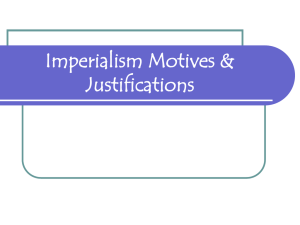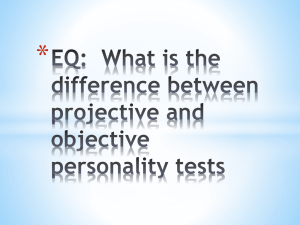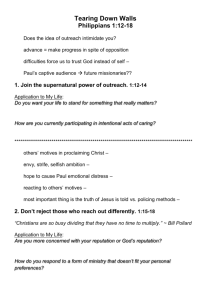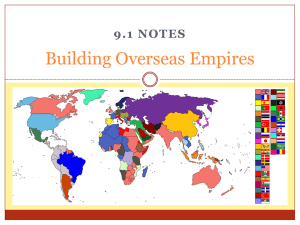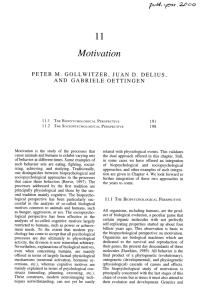Scoring motive imagery in running text: The Winter (1991)
advertisement
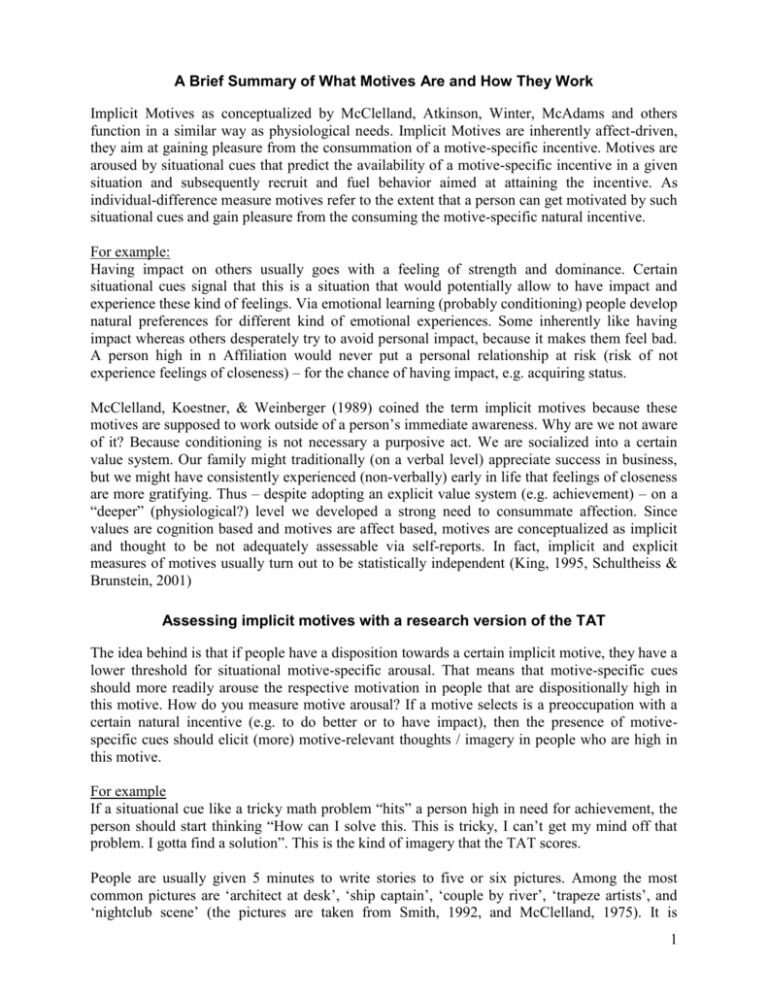
A Brief Summary of What Motives Are and How They Work Implicit Motives as conceptualized by McClelland, Atkinson, Winter, McAdams and others function in a similar way as physiological needs. Implicit Motives are inherently affect-driven, they aim at gaining pleasure from the consummation of a motive-specific incentive. Motives are aroused by situational cues that predict the availability of a motive-specific incentive in a given situation and subsequently recruit and fuel behavior aimed at attaining the incentive. As individual-difference measure motives refer to the extent that a person can get motivated by such situational cues and gain pleasure from the consuming the motive-specific natural incentive. For example: Having impact on others usually goes with a feeling of strength and dominance. Certain situational cues signal that this is a situation that would potentially allow to have impact and experience these kind of feelings. Via emotional learning (probably conditioning) people develop natural preferences for different kind of emotional experiences. Some inherently like having impact whereas others desperately try to avoid personal impact, because it makes them feel bad. A person high in n Affiliation would never put a personal relationship at risk (risk of not experience feelings of closeness) – for the chance of having impact, e.g. acquiring status. McClelland, Koestner, & Weinberger (1989) coined the term implicit motives because these motives are supposed to work outside of a person’s immediate awareness. Why are we not aware of it? Because conditioning is not necessary a purposive act. We are socialized into a certain value system. Our family might traditionally (on a verbal level) appreciate success in business, but we might have consistently experienced (non-verbally) early in life that feelings of closeness are more gratifying. Thus – despite adopting an explicit value system (e.g. achievement) – on a “deeper” (physiological?) level we developed a strong need to consummate affection. Since values are cognition based and motives are affect based, motives are conceptualized as implicit and thought to be not adequately assessable via self-reports. In fact, implicit and explicit measures of motives usually turn out to be statistically independent (King, 1995, Schultheiss & Brunstein, 2001) Assessing implicit motives with a research version of the TAT The idea behind is that if people have a disposition towards a certain implicit motive, they have a lower threshold for situational motive-specific arousal. That means that motive-specific cues should more readily arouse the respective motivation in people that are dispositionally high in this motive. How do you measure motive arousal? If a motive selects is a preoccupation with a certain natural incentive (e.g. to do better or to have impact), then the presence of motivespecific cues should elicit (more) motive-relevant thoughts / imagery in people who are high in this motive. For example If a situational cue like a tricky math problem “hits” a person high in need for achievement, the person should start thinking “How can I solve this. This is tricky, I can’t get my mind off that problem. I gotta find a solution”. This is the kind of imagery that the TAT scores. People are usually given 5 minutes to write stories to five or six pictures. Among the most common pictures are ‘architect at desk’, ‘ship captain’, ‘couple by river’, ‘trapeze artists’, and ‘nightclub scene’ (the pictures are taken from Smith, 1992, and McClelland, 1975). It is 1 important to create a relaxed test atmosphere that not in and on itself arouses achievement motivation. The good thing is, that – over and beyond scoring TAT stories you can score presidential speeches, children’s books, movie scenes, and any other spoken or written material. That can tell you a lot about a president, a group of people or even a society as a whole. Scoring motive imagery in running text: The Winter (1991)-System Compared to other available systems, the Winter-System has the advantage that it offers a solution for offering all three motives – n power, n affiliation and n achievement – simultaneously. In its scoring it combines the sometimes separate n intimacy and n affiliation in one score. Other researchers sometimes combine n power and n affiliation into an agency score and contrast it with a communion score (n intimacy & n affiliation) according to Bakan’s dichotomy. N Power Natural incentive: to have impact on other people or the world at large Reinforcing affect: Feeling of strength and dominance Coding Categories: 1. Strong impressive actions, that by nature have impact on other people or the world at large e.g., “we will erase terrorism from this planet” 2. Control or regulation e.g., “we will follow Bin Ladin wherever he puts his feet.” 3. Attempts to influence someone, manipulate someone e.g., “The dad wants to get his son interested in playing the violin” 2 4. Providing unrequested help, advice, support e.g., “I can help you with that.” 5. To impress others; references to prestige, status, reputation e.g., “He wants to appear smart” 6. Any intense (positive or negative) emotional reaction from a person, group, nation in response an action of a person, group, nation e.g., “The audience was amazed by the presentation she gave”. N Achievement Natural incentive: to do something better, improving on a task Reinforcing affect: Feeling of Pride Coding Categories: 1. Adjectives that evaluate a performance (good, better, best, excellent, …) e.g., “Our government has to strive for the highest ideals.” 2. Goals, performances or actions that are presented or evaluated in a positive way e.g., “The surgeon had to work fast and flawless”. 3. Mentioning success or successful competing against others e.g., “Our company has managed to make higher profits than our competitors.” 4. Failure, bad results or other deficits; negative feelings about a performance obstacle e.g., “She was mad that the bad weather hold her back from running faster”. 5. Unique achievements e.g., “She is about to develop a remedy against cancer.” N Affiliation Natural incentive: to have close, friendly contacts with others Reinforcing affect: Feeling of interpersonal warmth, love Coding Categories: 1. Expression of positive, friendly or intimate feelings about a person, a nation, etc. e.g., “Two old friends from high-school were glad to see each other again.” 2. Sadness or other negative feelings about separation or the end of a relationship or the will to reestablish it. e.g., “He felt lonely after she left him.” 3. Affiliative, friendly actions e.g., “After dinner they all set together, talked and laughed”. 4. friendly nurturing acts e.g., “She tried to comfort her friend in these hard times.” 3 Recommended Readings King, L. A. (1995). Wishes, motives, goals, and personal memories: Relations of measures of human motivation. Journal of Personality, 63, 985 – 1007. McClelland, D. C. (1989). Motivational factors in health and disease. American Psychologist, 44, 675 – 683. McClelland, D. C., Koestner, R., & Weinberger, J. (1989). How do self-attributed an implicit motives differ? Psychological Review, 96, 690 – 702. Schultheiss, O. C. (in press). An information processing account of implicit motive arousal. In M. L. Maehr & P. Pintrich (Eds.), Advances in motivation and achievement (Vol. 12: Methodology in motivation research). Greenwich, CT: JAI Press. Schultheiss, O. C., & Brunstein, J. C. (2001). Assessment of implicit motives with a research version of the TAT: Picture profiles, gender differences, and relations to other personality measures. Journal of Personality Assessment, 77(1), 71-86. Smith, C. P. (Ed.). (1992). Motivation and personality: Handbook of thematic content analysis. Cambridge, MA: Cambridge University Press. Winter D. G. (1991). Manual for scoring motive imagery in running text (3rd ed.). Department of Psychology, University of Michigan, Ann Arbor: Unpublished manuscript. 4



